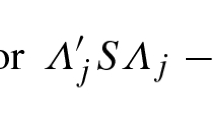Abstract
In econometric literature a parameter in a theoretical model has been called identifiable if it can be uniquely determined in terms of the joint probability distribution of the observed variables. In this paper the identifiability of parameters in four different factor analysis models is considered. The last of these four models corresponds to Thurstone's factor analysis. In Sections 7 and 11, the possibility of a statistical testing of the models is discussed. Section 10 deals with the problem of actually determining the parameterr (the number of common factors) in terms of the probability distribution of the observed variables.
Similar content being viewed by others
References
Albert, A. A. The matrices of factor analysis.Proc. nat. Acad. Sci., Wash., 1944,30, 90–95.
Albert, A. A. The minimum rank of a correlation matrix.Proc. nat. Acad. Sci., Wash., 1944,30, 144–146.
Haavelmo, T. The probability approach in econometrics. Supplement toEconometrica, 1944,12.
Hurwicz, L. Generalization of the concept of identification.Cowles Commission Monograph No. 10. Statistical inference in dynamic economic models. New York: John Wiley and Sons, 1949.
Kelley, T. L. Crossroads in the mind of man. Stanford University, Calif.: Stanford Univ. Press, 1928.
Koopmans, T. C., Rubin, H., and Leipnik, R. B. Measuring the equation systems of dynamic economics.Cowles Commission Monograph No. 10. New York: John Wiley and Sons, 1949.
Koopmans, T. C., and Reiersøl, O. The identification of structural characteristics. To be published.
Ledermann, W. On the rank of the reduced correlational matrix in multiple factor analysis.Psychometrika, 1937,2, 85–93.
Reiersøl, O. Confluence analysis by means of lag moments and other methods of confluence analysis,Econometrica, 1941,9, 1–24.
Thomson, G. H. The proof or disproof of the existence of general ability.Brit. J. Psychol., 1919,9, 323–336.
Thurstone, L. L. The vectors of mind. Chicago: Univ. Chicago Press, 1935.
Thurstone, L. L. Multiple-factor analysis. Chicago: Univ. Chicago Press, 1947.
Wilson, E. B., and Worcester, J. The resolution of four tests.Proc. nat. Acad. Sci., Wash., 1934,20, 189–192.
Wilson, E. B., and Worcester, J. The resolution of tests into two general factors.Proc. nat. Acad. Sci., Wash., 1938,25, 20–25.
Wilson, E. B., and Worcester, J. The resolution of six tests into three general factors.Proc. nat. Acad. Sci., Wash., 1939,25, 73–77.
Author information
Authors and Affiliations
Additional information
This article will be included in Cowles Commission Paper, New Series, No. 39.
Rights and permissions
About this article
Cite this article
Reiersøl, O. On the identifiability of parameters in Thurstone's multiple factor analysis. Psychometrika 15, 121–149 (1950). https://doi.org/10.1007/BF02289197
Received:
Revised:
Issue Date:
DOI: https://doi.org/10.1007/BF02289197




